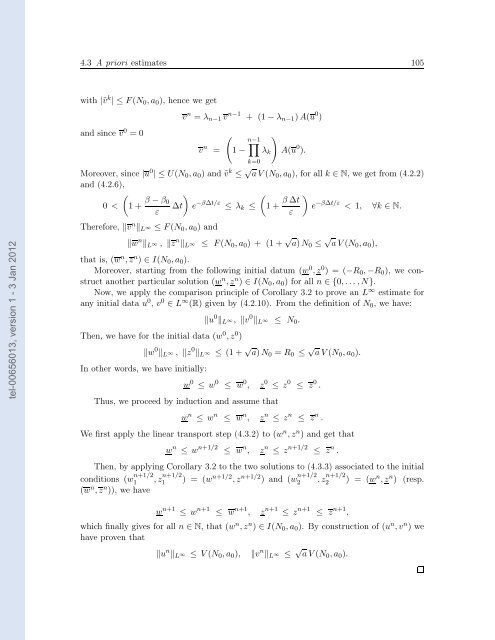Modélisation, analyse mathématique et simulations numériques de ...
Modélisation, analyse mathématique et simulations numériques de ...
Modélisation, analyse mathématique et simulations numériques de ...
Create successful ePaper yourself
Turn your PDF publications into a flip-book with our unique Google optimized e-Paper software.
tel-00656013, version 1 - 3 Jan 2012<br />
4.3 A priori estimates 105<br />
with |˜v k | ≤ F(N0,a0), hence we g<strong>et</strong><br />
and since v 0 = 0<br />
v n = λn−1v n−1 + (1−λn−1)A(u 0 )<br />
v n =<br />
<br />
1−<br />
n−1 <br />
k=0<br />
λk<br />
<br />
A(u 0 ).<br />
Moreover, since |u0 | ≤ U(N0,a0) and ˜v k ≤ √ aV(N0,a0), for all k ∈ N, we g<strong>et</strong> from (4.2.2)<br />
and (4.2.6),<br />
<br />
β −β0<br />
0 < 1+<br />
ε ∆t<br />
<br />
e −β∆t/ε <br />
≤ λk ≤ 1+ β∆t<br />
<br />
e<br />
ε<br />
−β∆t/ε < 1, ∀k ∈ N.<br />
Therefore, v n L ∞ ≤ F(N0,a0) and<br />
w n L ∞ , zn L ∞ ≤ F(N0,a0) + (1+ √ a)N0 ≤ √ aV(N0,a0),<br />
that is, (w n ,z n ) ∈ I(N0,a0).<br />
Moreover, starting from the following initial datum (w 0 ,z 0 ) = (−R0,−R0), we construct<br />
another particular solution (w n ,z n ) ∈ I(N0,a0) for all n ∈ {0,...,N}.<br />
Now, we apply the comparison principle of Corollary 3.2 to prove an L ∞ estimate for<br />
any initial data u 0 , v 0 ∈ L ∞ (R) given by (4.2.10). From the <strong>de</strong>finition of N0, we have:<br />
Then, we have for the initial data (w 0 ,z 0 )<br />
In other words, we have initially:<br />
u 0 L∞, v0L∞ ≤ N0.<br />
w 0 L ∞ , z0 L ∞ ≤ (1+√ a)N0 = R0 ≤ √ aV(N0,a0).<br />
w 0 ≤ w 0 ≤ w 0 , z 0 ≤ z 0 ≤ z 0 .<br />
Thus, we proceed by induction and assume that<br />
w n ≤ w n ≤ w n , z n ≤ z n ≤ z n .<br />
We first apply the linear transport step (4.3.2) to (w n ,z n ) and g<strong>et</strong> that<br />
w n ≤ w n+1/2 ≤ w n , z n ≤ z n+1/2 ≤ z n .<br />
Then, by applying Corollary 3.2 to the two solutions to (4.3.3) associated to the initial<br />
conditions (w n+1/2<br />
1 ,z n+1/2<br />
1 ) = (wn+1/2 ,zn+1/2 ) and (w n+1/2<br />
2 ,z n+1/2<br />
2 ) = (wn ,zn ) (resp.<br />
(wn ,zn )), we have<br />
w n+1 ≤ w n+1 ≤ w n+1 , z n+1 ≤ z n+1 ≤ z n+1 ,<br />
which finally gives for all n ∈ N, that (w n ,z n ) ∈ I(N0,a0). By construction of (u n ,v n ) we<br />
have proven that<br />
u n L ∞ ≤ V(N0,a0), v n L ∞ ≤ √ aV(N0,a0).

















